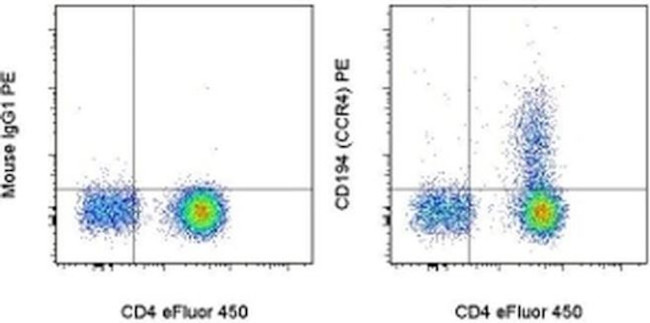Search Thermo Fisher Scientific
图: 1 / 2
CD194 (CCR4) Antibody (12-1949-42) in Flow


产品信息
12-1949-42
种属反应
已发表种属
宿主/亚型
分类
类型
克隆号
偶联物
激发/发射光谱
形式
浓度
纯化类型
保存液
内含物
保存条件
运输条件
RRID
产品详细信息
Description: This D8SEE monoclonal antibody reacts with human CD194 (CCR4). CD194, also known as C-C Chemokine Receptor 4 (CCR4) is a member of the G protein-coupled receptor family, a large family characterized by seven transmembrane alpha helical domains. The ligands for CCR4 are CCL17 (TARC) and CCL22 (MDC), which direct the migration of target cells. CCR4 and its ligands, along with the other receptors CCR10 and CLA, are particularly important for the recruitment of T cells into the skin, where they may also play a role in adhesion and extravasation. Although CCR4 expression was originally believed to be restricted to Th2 cells, it has since been observed in some subsets of Th17, Treg, and Th1 cells. It is not expressed by naive T cells, indicating a role in memory or effector function. Other cells that express CCR4 are activated NK cells, platelets, monocytes, and basophils.
Applications Reported: This D8SEE antibody has been reported for use in flow cytometric analysis.
Applications Tested: This D8SEE antibody has been pre-titrated and tested by flow cytometric anaylis of normal human peripheral blood cells. This can be used at 5 µL (0.25 µg) per test. A test is defined as the amount (µg) of antibody that will stain a cell sample in a final volume of 100 µL. Cell number should be determined empirically but can range from 10^5 to 10^8 cells/test.
Excitation: 488-561 nm; Emission: 578 nm; Laser: Blue Laser, Green Laser, Yellow-Green Laser.
Filtration: 0.2 µm post-manufacturing filtered.
靶标信息
CCR4 is a chemokine receptor and is preferentially expressed on type 2 helper T (Th2-type) cells. In contrast to other chemokine receptors, the expression of CCR4 and CCR8 on Th2 cells is transiently increased following TCR and CD28 engagement. Moreover, activated Th1 cells up-regulate CCR4 expression and functional responsiveness to thymus- and activation-regulated chemokine. Chemokines are a group of small (approximately 8 to 14 kD), mostly basic, structurally related molecules that regulate cell trafficking of various types of leukocytes through interactions with a subset of 7-transmembrane, G protein-coupled receptors. Chemokines also play fundamental roles in the development, homeostasis, and function of the immune system, and they have effects on cells of the central nervous system as well as on endothelial cells involved in angiogenesis or angiostasis. Chemokines are divided into 2 major subfamilies, CXC and CC, based on the arrangement of the first 2 of the 4 conserved cysteine residues; the 2 cysteines are separated by a single amino acid in CXC chemokines and are adjacent in CC chemokines.
仅用于科研。不用于诊断过程。未经明确授权不得转售。
How to use the Panel Builder
Watch the video to learn how to use the Invitrogen Flow Cytometry Panel Builder to build your next flow cytometry panel in 5 easy steps.
生物信息学
蛋白别名: C-C chemokine receptor type 4; C-C CKR-4; CCR-4; CD194; chemokine (C-C motif) receptor 4; chemokine (C-C) receptor 4; K5-5; MGC88293
基因别名: CC-CKR-4; CCR4; CD194; ChemR13; CKR4; CMKBR4; HGCN:14099; K5-5
UniProt ID: (Human) P51679
Entrez Gene ID: (Human) 1233




